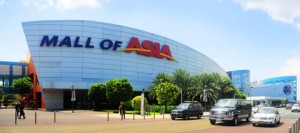
The Mall of Asia, in Manila, Philippines, is the 4th-largest shopping mall in the world. Photo credit: Ivan Tykhy, 2012.
Just a few years ago, the Philippines was dubbed as “the sick man of Asia.” Today, it is a regional star, with its stellar economic performance at 6.6% in 2012, coming second only to China’s 7.8%. Standard & Poor’s (S&P) elevated the country’s credit rating from “stable” to “positive,” and may, according to the Philippine Finance Minister, soon get an investment grade that will enable it to attract even more foreign direct investment (FDI). Likewise, the World Bank has for the third time upgraded the country’s growth forecast. Its stock market is one of the best performers in the region. According to HSBC estimates, if current trends hold up, the Philippines by 2050 can become the 16th largest economy in the world, a giant leap from its current ranking of 44th.
Private investments, especially in the retail industry, are creating major contributions to the country’s economic success, including the modest shopping mall. Shopping malls are proliferating in towns and cities far beyond Metro Manila. According to data provided by the Philippine Retailers Association, shopping malls account for about 15% of the country’s GNP and 33% of the entire services sector. They employ about 18% of the Philippine labor force, translating into about 5.25 million employed Filipinos.
In Metro Manila alone, there are about 15 major shopping malls, with 11malls already under construction, yet to be added. Aside from these major malls, there are hundreds of community malls, used-goods markets, lifestyle malls, and strip malls distributed throughout the city. In the provinces, the trend is catching up. There are about 200 major shopping centers located outside Manila in the Philippines provinces, from northern Luzon to southern Mindanao. Henry Sy, a Filipino-Chinese billionaire investor and owner of the biggest Philippines department store chain, is planning to spend $1.5 billion for additional malls in the provinces. He will also use some of this investment money for his expansion efforts in China, where his company is opening its fifth mall. In China, the company says, the focus will be on less-affluent or second-tier cities. The company believes that there are still plenty of opportunities in both countries where consumer spending is sustainable and will continue to grow.
Expect that as malls proliferate, schools, colleges and trade schools will increase in number, exponentially increasing economic growth through an educational multiplier effect. The role of department stores as transformative institutions is nothing new. In a recent PBS show focusing on commercial history, both manufacturing and shopping were highlighted. It featured an American-born founder of the London department store, Mr. Harry Selfridge, who shared his retailing techniques with his UK partners in the early 20th century. In her piece, “How Mr. Selfridge Created the Modern Economy,” Virginia Postrel, a Bloomberg columnist, describes the early impact of department stores:
Yet like railroads and telegraphs, the department stores of the late 19th and early 20th century were socially and economically transformative institutions. They pioneered innovations ranging from inventory control and installment credit to ventilation systems, electric lighting and steel construction, along with new merchandising and advertising techniques. They brought together goods from all over the world and lit up city streets with their window displays. They significantly changed the role of women, giving them new career opportunities and respectable places to meet in public. They popularized bicycles, cosmetics, ready-to-wear clothing and electrical appliances. They even invented the ladies’ room.
In the Philippines, the impact of shopping malls is even greater as it contributes to the changing social and political landscapes of the country. Malls have a way of urbanizing rural areas. The class-conscious, Manila-centric, elite mentality is now being challenged by talents and resources in the provinces. The narrowing of the urban-rural divide has a way of narrowing income gaps, increasing the purchasing power of the poor, decreasing inefficiencies, and incentivizing the education and skilling of the workforce. The modest shopping mall is an indicator of future economic growth, and the Philippines is building them at a very rapid rate.
JPR Blog
